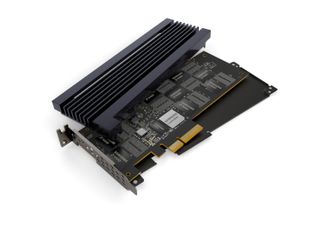Samsung Releases SZ985 Z-SSD In 240GB And 800GB Capacities

Samsung announced that it is shipping its new enterprise Z-SSDs, which come with a radical new flavor of existing NAND technology, in 800GB and 240GB capacity points.
Samsung designed the new Z-SSD takes the fight to Intel and Micron's 3D XPoint memory. However, 3D XPoint is a completely new type of memory that has only surfaced in Intel's relatively expensive Optane products, while Samsung's Z-SSD comes with Z-NAND, which is a heavily modified version of existing NAND technology. That should ostensibly provide faster performance than normal SSDs but at a lower price point.
We last heard of Samsung's Z-SSDs in November 2017 when the company released a performance brief. Today's announcement offers a few more details, but not many.
| Header Cell - Column 0 | Samsung SZ985 Z-NAND SSD | Intel Optane (3D XPoint) | Samsung PM1725a | Intel DC P3700 |
|---|---|---|---|---|
| Interface | PCIe 3.0 x4 | PCIe 3.0 x4 | PCIe 3.0 x8 | PCIe 3.0 x4 |
| Media | Z-NAND | 3D XPoint | 48-layer 3D TLC NAND | 20nm MLC NAND |
| Sequential Read/Write (GB/s) | 3.2 / 3.2 | 2.4 / 2 | 6.4 / 3 | 2.8 / 2 |
| Random Read/Write IOPS | 750,000 / 170,000 | 550,000 / 500,000 | 1,080,000* / 170,000 | 460,000 / 175,000 |
| Random Read Latency | 12 - 20µs | 10µs | 90µs | 115µs |
| Random Write Latency (typ) | 16µs | 10µs | 20µs | 25µs |
| Drive Writes Per Day (DWPD) | 30 | 30 | 5 | 17 |
| Capacity | 800GB | 350 / 750GB | 1.6 / 3.2 / 6.4TB | 400 - 800GB / 1.6 - 2TB |
The Z-SSD is a single-port four-lane design, which means that it doesn't come with the dual-port functionality that we see with some new enterprise-class NVMe SSDs. Samsung claims the Z-NAND chips provide up to 10X the cell read performance of current-generation TLC 3D NAND, but those types of advances don't always equate to an equivalent level of performance for the end device.
Samsung did pair the Z-SSD with a newer high-performance controller and 1.5GB of LPDDR4 DRAM. SSDs tend to use 1MB of DRAM per 1GB of NAND storage, so the 1.5GB of DDR4 doesn't mesh well with the 800GB of addressable capacity. This could mean the SSD may have 1.5TB of Z-NAND onboard, with nearly half of the capacity dedicated to performance-boosting overprovisioning. However, most enterprise SSDs use DRAM in an ECC arrangement to ensure recoverability from errors, which likely explains part of the extra capacity.
Samsung says the SZ985 offers up to 750,000/170,000 random read/write IOPS and a random write latency of 16 microseconds. We covered those specifications, and how they translate to application performance, in our previous coverage. As with performance metrics from any company, we will have to take them with a grain of salt, but the application testing results do look promising. Samsung hasn't released QoS or mixed random workload performance metrics, which are notable strengths of 3D XPoint-powered SSDs. Given the SZ985's NAND-like random write IOPS specification, we imagine it wouldn't fare as well during mixed workloads.
The company also says the SSD has an MTBF of 2 million hours and 30 DWPD (Drive Writes Per Day) of endurance, but it still isn't sharing details of its new Z-NAND technology. Samsung says Z-NAND features a "unique circuit design" that could mean shorter bitlines and wordlines in the NAND package. The NAND die could also have more planes, which are sections of the die that respond independently to data requests, to boost performance. We do know that it stores one bit per cell (SLC).
Stay on the Cutting Edge
Join the experts who read Tom's Hardware for the inside track on enthusiast PC tech news — and have for over 25 years. We'll send breaking news and in-depth reviews of CPUs, GPUs, AI, maker hardware and more straight to your inbox.
Samsung hasn't shared pricing for the new drives yet, but it will introduce them at the ISSCC 2018 (International Solid-State Circuits Conference), which will be held February 11-15 in San Francisco.

Paul Alcorn is the Managing Editor: News and Emerging Tech for Tom's Hardware US. He also writes news and reviews on CPUs, storage, and enterprise hardware.
Most Popular



